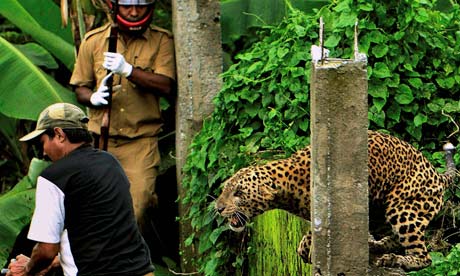 The recent story of India’s rising tiger population is good news, but it is only half the picture. If the report submitted by the ministry of environment and forests is read fully and carefully, it also shows that while there are more number of tigers, their habitat has shrunk leaving the wild cats in a more vulnerable situation than ever before.
The recent story of India’s rising tiger population is good news, but it is only half the picture. If the report submitted by the ministry of environment and forests is read fully and carefully, it also shows that while there are more number of tigers, their habitat has shrunk leaving the wild cats in a more vulnerable situation than ever before.
A collective sigh of relief was heard from environmentalists all over the world when a few months back India declared a 20 percent rise in its tiger numbers from 1411 in 2006 to 1706 in 2011.
This countrywide assessment of tigers, in 17 tiger states, involved 477,000 work-days by forest staff and 37,000 work-days by professional biologists, making it the largest exercise of its kind in the world.
“After the 2006 pan India tiger population estimation, the present exercise is even more comprehensive in terms of the area covered and methodologies used,” said Mr. Ravi Singh, Secretary General and CEO of WWF India. “The involvement of conservation partners, including WWF, has led to broad based efforts and built a stronger constituency and capacity for tiger conservation in India.”
But apart from the encouraging numbers what the report also mentioned was that in all there has been a 12.6 percent loss of habitat. What this means is that now there are more tigers squeezed in a very small area and which means it can lead to,
- More human-tiger conflict
- Lack of spreading out of the tigers and thereby leading to loss of genetic exchange between populations.
What the authors of the report now fear is that if tiger population is eradicated at one place, they can still be re-introduced, but if they do not have any place to live, no amount of re-introduction and relocation can make them survive.
Dr. Y V Jhala, lead author of the report said, “The loss of corridors does not bode well for the tiger. Poaching can wipe out individual tiger populations, but these can be re-established by reintroductions as has been done in the Sariska and Panna Reserves. However, once habitats are lost, it is almost impossible to claim them back for restoration.”
The tiger report also states that tigers need a well balanced ecosystem to survive. This means that they need to live in a habitat that has ample green coverage and a good amount of prey population. They also need safe breeding areas.
“These results are encouraging, and we congratulate all the partners in India for achieving something like this on a scale never attempted before. This huge task undertaken by the partners perfectly represents the scale of action we need to take to turn around the future for the tiger,” said Mike Baltzer, Leader of WWF’s Tigers Alive Initiative “Unfortunately, while the results indicate an increase, they also provide evidence of even more pressure on the tiger and its habitat, we must keep up the momentum and redouble our efforts to ensure the tiger has a future in India and throughout its range in Asia and the Russian Far East.”
Therefore, the problem now is not only increasing the number of India’s national animal but providing it with a home that it is comfortable in and making sure that development and infrastructure do not trample on the land that belongs to the king of the jungle.
Related Stories:
India’s Old Age Home for Tigers to come up in West Bengal
India’s Claim of Increased Forest Cover may be False say Researchers
Orphaned Tiger ready to begin Life at Bhopal’s Van Vihar
Article reference: WWF






With increasing population and with increasing push for exploitation of India’s resources for “development”, how will the land for protected areas increase?
Absolutely true Sunil. It is a fear that we live with everyday.
I still doubt the latest figures by the Govt. In a country where we talk too much and work too less, its unbelievable to see the Tiger numbers go up, when we have hardly done anything towards safeguarding them. On the contrary we have only done more harm by giving away forest lands to mining mafias/allow poachers to hunt them down/mysterious diseases killing tigers under protection…
The fact still remains, whether the number have “genuinely” gone up or not, there’s nothing to cheer about, after reading your article. The future is still grim for the Tiger.
I agree Prashanth. The sundarbans tigers were never counted during the last census and even today many states ‘claim’ they have more tigers than what was shown in the present census. While the debate will go on, the loss will be ultimatley the tigers.
An excellent write-up. In a world which barely cares for preserving wildlife and nature, your article is a wake up call!. Simply wonderful.
http://dharbarkha.blogspot.com/2011/08/child-pornography-sexploitation-on.html
Thanks Barkha. Maybe words will encourage people to act.
This would mean that tigers will start straying into human-occupied territories, which will result in a backlash with tigers being killed, leading to numbers coming down… The cycle will continue
Exactly Sudha. The leopard human conflict has already taken a vicious turn. I am afraid if tigers are not given a larger area to live in, the future will only turn worse for them.